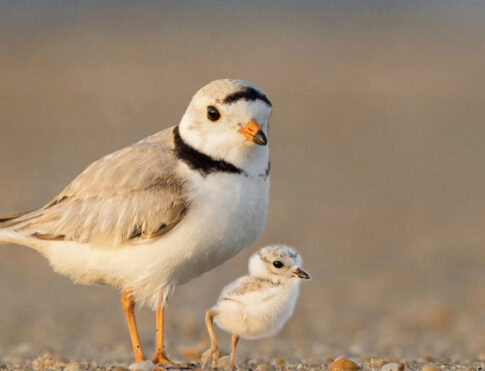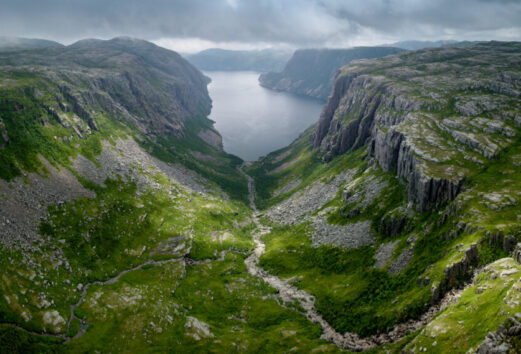South Coast Fjords
The South Coast Fjord Area
The southwest coast of Newfoundland, extending from Hermitage Bay to Cape Ray, is characterized by high granite cliffs and deep, glacially-carved fjords. These fjords create many sheltered inlets and habitats for a variety of marine species and this area is home to the largest tides in Newfoundland. Seaweeds in the Bay d’Espoir area exhibit extremely high diversity, especially in the intertidal zone. CPAWS-NL has been advocating for conservation within this area since the chapter’s establishment in the province in 2003.
The recent agreement between Canada and the province to accelerate the creation of new protected areas aims to decrease biodiversity loss and includes a feasibility assessment of a South Coast Fjords national marine conservation area (NMCA) and an adjacent national park in the Burgeo region. A South Coast Fjords NMCA and the potential adjacent national park will create many ecological, economic, and cultural benefits for coastal communities. We welcomed the agreement and new commitments by governments and look forward to what conservation measures are implemented going forward. Read our full statement here.
Special Features
Newfoundland and Labrador is known for its exquisite natural beauty and productive coastal waters, and the South Coast Fjords are a perfect example of such. The area is a haven for species like blue, humpback, fin and killer whales in the winter and leatherback sea turtles in the summer. The establishment of the South Coast Fjords NMCA will preserve endangered species and ecosystems – both of which are important criteria for Canada’s network of marine protected areas. The Hermitage Channel is a large, highly-stratified fjord, carrying warm and saline deep-water layer from the Laurentian Channel into Hermitage and Fortune Bays.
Many marine mammals and rare species follow this route to feed in the sheltered bays, including leatherback turtles, harbour porpoises, and humpback, fin, blue, right, and killer whales. Endangered porbeagle sharks are also known to aggregate off Pass Island. The Burgeo Sandbanks contain extensive beaches and marshes, which provide habitat for the globally-vulnerable Piping Plover.
Protection
In order to prevent further habitat and biodiversity loss, CPAWS-NL is lobbying for increased enforcement, improved surveillance, and higher fines and capture of polluters within the area. The waters off the south coast of Newfoundland are within a major shipping route from the Gulf of St. Lawrence, resulting in a significant amount of large vessel traffic. Ferry routes between Hermitage – McCallum, Burgeo – Grey River, Rose Blanche – La Poile, and Port-AuxBasques to North Sydney bring additional traffic to the region. Marine traffic brings with it a threat of oil pollution due to spills and illegal discharges, which is lethal to seabirds. Because of the currents, wind and tides, pollution can affect inshore areas, too. To prevent marine oil pollution, we have suggested convenient and accessible onshore oil disposal facilities for bilge and oil-contaminated ballast water.
We believe protection options should be explored for the south coast of Newfoundland to assist in recovering depleted fish stocks and maintaining the health of marine ecosystems. Management agencies should work with local communities and the fishing industry to explore alternative gear types to reduce the amount of by-catch.
While some protection exists for several small coastal sites, further discussions should be made between management agencies and local communities to explore options for strengthening protection and extending coverage into sub-tidal areas. Sensitive dune areas serve as habitats and nesting zones for shorebirds and the increased pedestrian and recreational vehicle traffic here can be quite harmful. We believe a habitat protection strategy would be beneficial. Implementing a public education and stewardship program with increased surveillance and stricter fines would help deter irresponsible activity and protect precious habitats.
Threats
Collisions with ships, net entanglements, and pollution are threats to marine mammals including the endangered Blue Whale, and the endangered Leatherback Turtle, who frequent the region. Construction is underway on the Marine Link by Emera Inc., which involves the development of a transmission line between Granite Canal, Newfoundland and Woodbine, Nova Scotia. The transmission line will be buried across the Cabot Strait with a known disturbance to coral benthic communities, groundfish species, and marine wildlife.
Aquaculture projects have been aggressively pursued in Hermitage and Fortune Bays. Production has more than tripled since 2003 with approximately 80 finfish sites and 4 shellfish sites licensed. There are concerns about the impacts of aquaculture that include the genetic mixing of escapes with wild species, disease control, and habitat modification. Given that the South Newfoundland population of Atlantic Salmon has been identified as threatened by COSEWIC and considering the large uncertainties surrounding the potentially significant negative environmental effects of net-pen aquaculture, any aquaculture expansion proposals in this area are of great public concern and should be well-scrutinized. Overfishing and irresponsible fishing are lingering issues throughout this region. There has been heavy fishing in the North Shore – Fortune Bay area since early settlement. American Plaice, a species that is under moratorium, is often caught as by-catch in the cod fishery on Burgeo Bank.
Several sensitive beach areas at Burgeo – Sandbanks, J.T. Cheeseman Provincial Park, and Grand Bay West, are threatened by the aforementioned human activities. The presence of dogs off-leash can lead to death of Piping Plover chicks. Sea level rise due to climate change is also expected to increase erosion in the area.
For more information on the South Coast Fjords check out the latest edition of the Special Marine Areas Guide.


